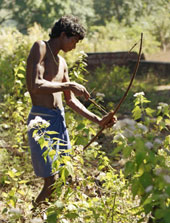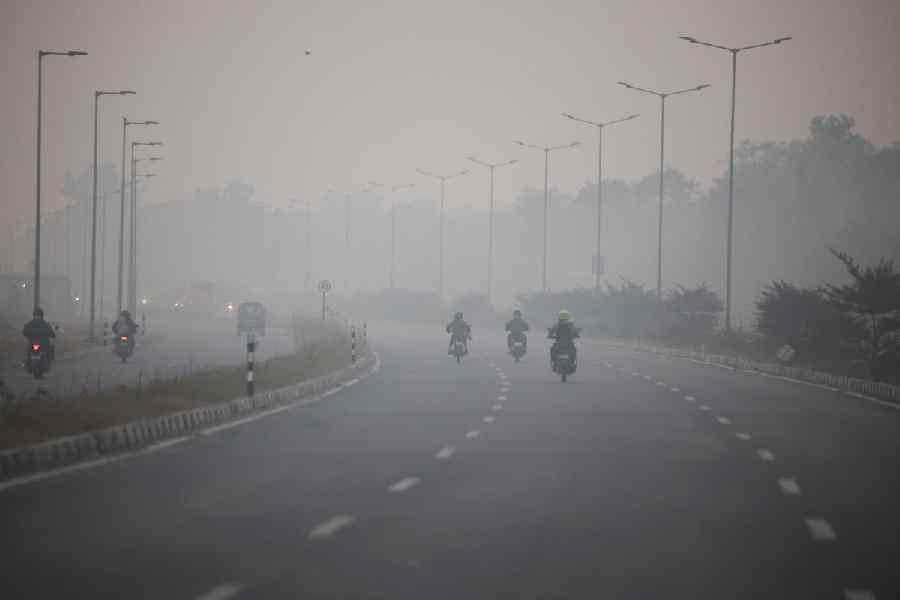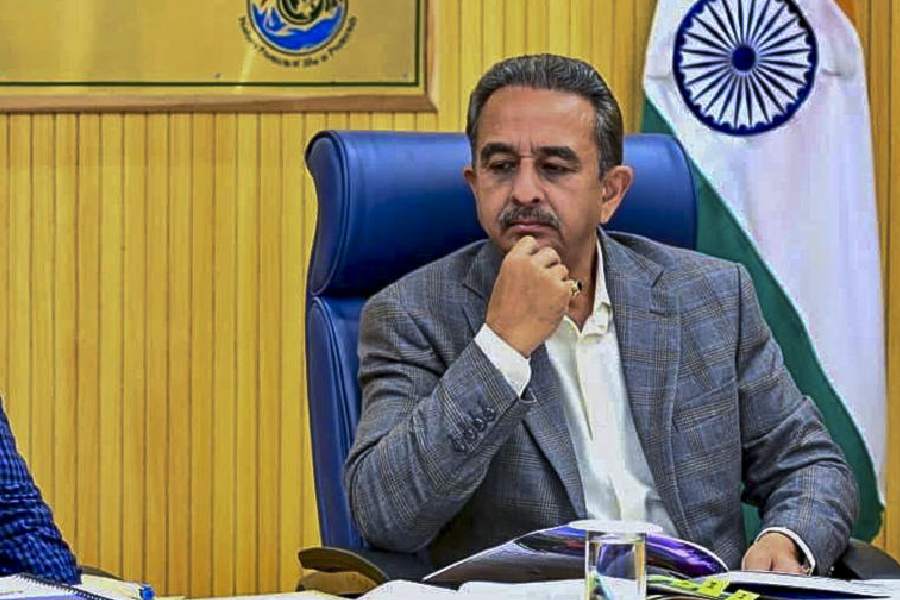|
|
| NO MAN’S LAND: Tribals share an intimate relationship with their natural surroundings |
Like many in Gellaguda, a tribal village in Orissa’s far-flung Koraput district, Joy Mundagudia can’t figure out the forest department. To him, foresters seem more interested in cutting off villagers from their land than in keeping the “outsiders” from plundering the forests.
“They insist on planting trees in areas where we have been growing paddy and vegetables for ages,” the wiry man, who has no idea of his age but looks to be in his 30s, says, as a swarm of villagers gathered around him nod in agreement. To make his point, Mundagudia pauses and then picks up a stone and hurls it towards a plantation of cashew and eucalyptus trees on a hillside. “Seiti Seiti (over there, over there),” he shouts out, as the rock goes down in an arc.
More than 600 km away from the state capital Bhubaneswar, Gellaguda falls under the Dandrakhol reserve forest, according to a forest department sign standing near the village. Like thousands of forest dwellers elsewhere in the country, Gellaguda residents, mostly from the Gadaba tribe, have no right to their land they have been living on for generations.
They have no pattas or land deeds; they receive no facilities from the government, not even the BPL (below poverty line) cards that could help them buy subsidised rice. In government records, they are nothing but “illegals”.
Their fate was sealed when the country’s first forest policy was drafted in the early 1950s. “It stated that the accident of being a group of tribals remaining inside forests does not give them the privilege and right to use what it called a national property,” P.C. Mohapatra, director of the Koraput-based Council of Analytical Tribal Studies, says.
The subsequent Forest Conservation Act of 1980 went a step further, virtually making them “illegal occupants” of their own land. They have since been barred from use of any land notified or recorded as forest.
This was all done, of course, in the name of “protecting” forests. And therein, ironically, lies the failure of the country’s forest policy. The exclusionary approach to forest conservation ? which clearly sought to keep the tribals from forests ? has not only failed to stop large-scale destruction of forests, but also condemned millions of tribal people to a life of penury and exploitation.
Down the ages
In a bid to “undo the historical injustice” meted out to the tribal communities, the Manmohan Singh government is now trying to bring about a legislation, giving them pattas for forest land occupied before 1980. The legislation also aims at curbing the growing influence of Naxalites in the tribal belts across the country.
However, the fate of the Scheduled Tribes (Recognition of Forest Rights) Bill, which also proposes to give the tribals “grazing and ownership” rights to forest resources, has been in a limbo with the Union ministry of environment and forest and the wildlife activists opposing it.
Two-and-a-half decades ago, Gellaguda residents had to hack their way through the forests in the area. “It was so dense that it was dark even at midday,” Narasingha Khilla, a villager, says. To top it, there was the fear of encountering a tiger.
Then, contractors, appointed by government, moved in apparently to build roads. Gellaguda, after all, lies on the road to Gupteswar, a popular tourist spot in south Orissa.
Villagers saw the trees chopped down and trucked away. At times, Khilla says they, too, were engaged by these contractors to help fell trees for a daily wage of Rs 20. Consequently, the forest thinned out. It’s no longer dark, nor dense.
With bald hills all around, the forest, in some areas, seems like a football ground, cleared of all trees. Sawed-off stumps of the trees litter the once-dense forest, a blot on the landscape. A few boars and bears are all left by way of wildlife in the area.
Though the tribals, who carry out shifting cultivation, are often blamed for the destruction of forests, it’s the government that is actually at fault, experts say. Stephen Behera, a retired conservator of forests from Orissa, says forests were mostly lost to a slew of development projects carried out over the last four decades.
“The government alone can say how much forests were lost to build roads, railway tracks, irrigation and other infrastructures,” he says.
Koraput is a case in point. Large swathes of forests were lost to build Balimela, Upper Kolab and Machkund hydro-electricity projects, in the undivided Koraput, now split into four districts in Orissa. Vast tracts of forests were cleared in the region through the Sixties and Seventies to settle refugees under the Dandakarenya project.
“The amount of forest land lost because of the shifting cultivation by the tribals would pale beside the vast tracts of forests lost because of these government projects. So, why blame the tribals and not the government for destruction of forests?” Mohapatra says.
The blame game
Not long ago, Phandi, barely 10 km from Koraput town, was a village surrounded by forests. But now only a few trees stand there. Ask Dinu Honthal how this happened and the villager points to a vast expanse of water in the distance. “We have not cleared our forest. This Kolab reservoir swallowed it up,” he says.
Behara says he had seen during his long career as an Indian forest service officer that government had often cleared more forests for projects than necessary. Large-scale theft of timber and overexploitation of forest resources by government-appointed agencies have also contributed to depletion of forests, he says.
Padma Gadaba, an old woman from Gellaguda, says the village always lived off the forest during lean seasons, collecting bamboo shoots, sal seeds, mahul and local fruits such as dimri and chakuri. They also collected seven types of roots from the forest, which they boiled and ate for supper. But with the forest thinning, there is food scarcity in the village.
“They are not allowing us to grow paddy by planting trees in our cultivable land. They are also clearing the forests. We don’t know where we are going to get our food from in future,” the woman, who is also the village shaman, says.
It’s not as if the government has not realised the futility of its forest policy. But the joint forest management (JFM) programmes involving tribals often get bogged down by inter-departmental rivalry.
Gupteswar Panigrahy, a lawyer at Koraput court, was delighted when tribals of Enugu village in Lamtaput block got 50 per cent of the non-timber forest products under a JFM agreement with the forest department in late 1998.
Trouble began two years later when the state cashew corporation claimed the land belonged to it and not to the forest department. The corporation filed police complaints against the tribals, accusing them of stealing cashew nuts. The result: the JFM programme was abandoned. “I am now fighting the case on behalf of these poor tribals,” Panigrahy says.
What galled the lawyer most was when some officials accused the tribals of clearing the forests for timber. “How many furniture do they use to deserve such false accusations?” he asks.
Give them a chance
The forest officials, not surprisingly, disagree. S.B. Samanta, the forest conservator of Koraput, feels the bill could pave the way for destruction of whatever forests the country is left with. “There should have been a national debate involving all stake-holders of the forests, including the forest department,” he says.
Samanta feels the tribals should be relocated wherever possible to the land belonging to the revenue department. “Give these people a chance to develop. Attempts should not be made to keep them inside the forests and thus underdeveloped,” the Indian forest service officer says.
Some tribal rights activists feel the bill alone is not enough. “Giving them pattas alone will not do. The government should make sure there is healthcare and public distribution system in tribal areas,” Anuradha, an activist with a local NGO, says.
But for the moment, all that Mundagudia of Gellaguda wants is patta for his land. Or else, he fears, a forest of eucalyptus will soon replace his shrinking plot of paddy. There will be a lush green forest ? but forest-dweller Mundagudia and his family will have nothing to eat.
KILL BILL - BISHAKHA DE SARKAR
Split wide open
 |
| Caught in a bind: Is the tiger’s future at stake? |
Three little words — man versus beast — have been rocking Lutyens’s Delhi like never before. The summer of 2005 has set two powerful groups afire on the debate that is as old as the hills. And the jury is still out.
The Scheduled Tribes (Recognition of Forest Rights) Bill has caused a vertical fissure among politicians and environmentalists. The Bill was to have been tabled in Parliament in its Budget session, but has been put on hold. Agitating for its passage are members of indigenous communities, Left parties and people’s groups. On the other side are environmentalists and a group of powerful MPs who recently set up a tiger-watch committee. The group — comprising senior leaders such as Karan Singh and K. Natwar Singh, also includes younger MPs Rahul Gandhi, Jyotiraditya Scindia and Jay Panda.
The last time a bill caused this kind of a vertical fissure was when parliamentarians went ballistic over a proposed law that sought to reserve seats for women in elected bodies. Now, with the Women’s Reservation Bill on the political back-burner, the focus is on the tribes Bill.
“The Bill will come up,” asserts Tribal Affairs Minister P.R. Kyndiah. “It will be taken up by the Cabinet shortly,” he says.
But the detractors of the Bill have strong lobbies. The environment ministry believes that forests would be adversely affected, and animal rights groups stress that endangered species would disappear if the Bill is enacted. But Avdhash Kaushal, the chairperson of the Dehradun-based Rural Litigation and Entitlement Kendra, a group working with Himalayan tribal nomads, jeers at the “efforts of the ex-Maharajas and poachers”. He says that Prime Minister Manmohan Singh is slated to discuss the Bill soon with Kyndiah, Panchayati Raj minister Mani Shankar Aiyar and rural development minister Raghuvansh Singh.
The supporters of the Bill — which is included in the Common Minimum Programme of the United Progressive Alliance government and is said to be the brain-child of activist-members of Congress President Sonia Gandhi’s National Advisory Council —seek to stress that Gandhi is with them on the issue as well. “At a meeting, she pointed out that the forests or animals were not threatened by tribals, but by the forest mafia,” says Kaushal, who adds that Rahul Gandhi has been absenting himself from the tiger watchers’ meetings.
But even among the detractors of the Bill, there are divisions, with several activists speaking out in favour of the rights of the people. A wild-life expert says that discusions are on in environmental circles, and an effort is on to evolve a consensus. “At the end of it, we all want one thing — conservation of forests, whether for the people or the animals,” says the conservationist.
Academics such as Teen Murti Fellow Archana Prasad believe the Bill has several grey areas that need to be addressed. “But we must table it first, and then look at ways of plugging the loopholes,” she says.
Wild-life and tribal rights activists, however, warn that there are powerful lobbies — including the timber mafia — waiting in the wings. “We should remember that they are standing at the gates, just waiting to come in,” says the conservationist.












